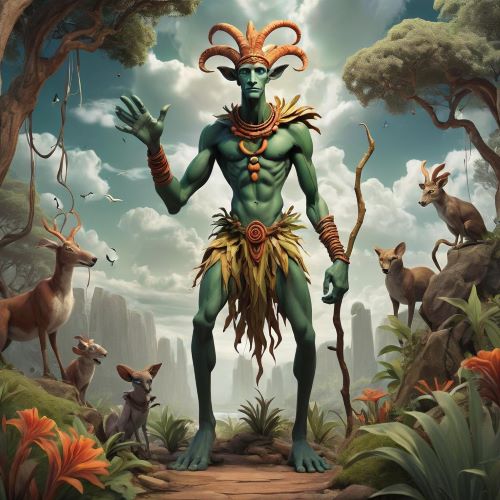San Gods
San Gods are central figures in the mythology of the San people, also known as the Bushmen, one of the oldest continuous cultures in the world. Living across southern Africa, the San have passed down their rich spiritual traditions through generations of storytelling, rock art, and ritual. San Gods are deeply intertwined with the land and natural world, embodying elements such as the sun, moon, animals, and ancestral forces. These deities are not distant beings but active participants in daily life, shaping the environment, guiding human behavior, and maintaining a delicate balance between the seen and unseen worlds.
Among the most well-known San Gods is /Kaggen, often portrayed as a trickster and creator god who can transform into various animals, especially the mantis. /Kaggen plays a central role in many stories, crafting the world and all its creatures, yet also displaying human-like flaws that teach moral lessons. His unpredictable nature reflects the San worldview, where survival requires adaptability and respect for nature’s power. Other divine figures include the Moon and Sun gods, who are associated with life cycles, timekeeping, and spiritual insight. Each San God carries symbolic meanings that explain natural phenomena and offer guidance for living in harmony with the earth.
San religious beliefs are deeply connected to the concept of trance and the spirit world. Shamans, or spiritual healers, act as mediators between the human and divine realms, often calling upon San Gods during trance dances. These sacred rituals involve rhythmic dancing, chanting, and altered states of consciousness that allow the shamans to communicate with gods and ancestral spirits. In these trances, messages from the divine are received to heal illness, protect the community, and maintain cosmic order. The presence of San Gods in these ceremonies highlights their role as both creators and caretakers of the spiritual world.
Rock art created by the San people also reflects the significance of their gods, often depicting animals, spirit beings, and trance scenes. These artworks serve as visual records of sacred experiences and divine encounters, offering insight into how San Gods were worshipped and remembered. Unlike written texts, these symbolic images are embedded in the landscape, reinforcing the belief that the divine is all around and accessible through nature. These sacred sites are still honored today, serving as spiritual touchstones and cultural heritage for San descendants and communities interested in indigenous spirituality.
Today, the stories and symbols of San Gods continue to inspire curiosity, reverence, and scholarly interest. As the world increasingly seeks to reconnect with nature and traditional knowledge systems, the spiritual wisdom of the San offers a unique and valuable perspective. Preserving and understanding the mythology of San Gods not only honors one of humanity’s most ancient belief systems but also reinforces the deep connections between people, land, and the divine. These gods remain powerful reminders of a sacred world where everything is alive, interconnected, and meaningful.
San Gods are central figures in the mythology of the San people, also known as the Bushmen, one of the oldest continuous cultures in the world. Living across southern Africa, the San have passed down their rich spiritual traditions through generations of storytelling, rock art, and ritual. San Gods are deeply intertwined with the land and natural world, embodying elements such as the sun, moon, animals, and ancestral forces. These deities are not distant beings but active participants in daily life, shaping the environment, guiding human behavior, and maintaining a delicate balance between the seen and unseen worlds.
Among the most well-known San Gods is /Kaggen, often portrayed as a trickster and creator god who can transform into various animals, especially the mantis. /Kaggen plays a central role in many stories, crafting the world and all its creatures, yet also displaying human-like flaws that teach moral lessons. His unpredictable nature reflects the San worldview, where survival requires adaptability and respect for nature’s power. Other divine figures include the Moon and Sun gods, who are associated with life cycles, timekeeping, and spiritual insight. Each San God carries symbolic meanings that explain natural phenomena and offer guidance for living in harmony with the earth.
San religious beliefs are deeply connected to the concept of trance and the spirit world. Shamans, or spiritual healers, act as mediators between the human and divine realms, often calling upon San Gods during trance dances. These sacred rituals involve rhythmic dancing, chanting, and altered states of consciousness that allow the shamans to communicate with gods and ancestral spirits. In these trances, messages from the divine are received to heal illness, protect the community, and maintain cosmic order. The presence of San Gods in these ceremonies highlights their role as both creators and caretakers of the spiritual world.
Rock art created by the San people also reflects the significance of their gods, often depicting animals, spirit beings, and trance scenes. These artworks serve as visual records of sacred experiences and divine encounters, offering insight into how San Gods were worshipped and remembered. Unlike written texts, these symbolic images are embedded in the landscape, reinforcing the belief that the divine is all around and accessible through nature. These sacred sites are still honored today, serving as spiritual touchstones and cultural heritage for San descendants and communities interested in indigenous spirituality.
Today, the stories and symbols of San Gods continue to inspire curiosity, reverence, and scholarly interest. As the world increasingly seeks to reconnect with nature and traditional knowledge systems, the spiritual wisdom of the San offers a unique and valuable perspective. Preserving and understanding the mythology of San Gods not only honors one of humanity’s most ancient belief systems but also reinforces the deep connections between people, land, and the divine. These gods remain powerful reminders of a sacred world where everything is alive, interconnected, and meaningful.


